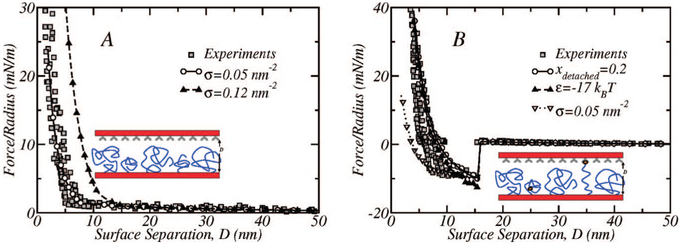Figure 10.
Comparison of the theoretical results with experimental data (filled squares) published in ref 31 (A) Experimental and calculated force profiles for a 5k–2k nonligated layer with x2k = 0.4 and total polymer surface coverage, σ = 0.12 nm−2. The theoretical profile for the same layer but having a lower surface coverage, σ = 0.05 nm−2, is also shown. (B) The SFA experiments correspond to the interaction of a streptavidin surface and a surface grafted with a 5k–2kL polymer layer where the ligand is biotin. The theoretical curve (open circles joined by a solid line) corresponds to a 5k–2kL layer with the same surface coverage, σ = 0.12 nm−2, and fraction of ligand functionalized polymers x2kL = 0.4, as in the experiments; the binding energy is ε = −35kBT, which corresponds to the biotin–streptavidin binding strength. In the theoretical case, only 80% of the ligand modified polymers are allowed to bind the receptor surface to account for the inuence of lipid detachment (see discussion below). Two more calculations for the same layer are shown. In one case the binding energy is lower, ε = −17kBT, and in the other the surface coverage is σ = 0.05 nm−2 (as in one of the calculations shown in Figure 10A). In both of these cases all ligated polymers can bind the opposed surface.

